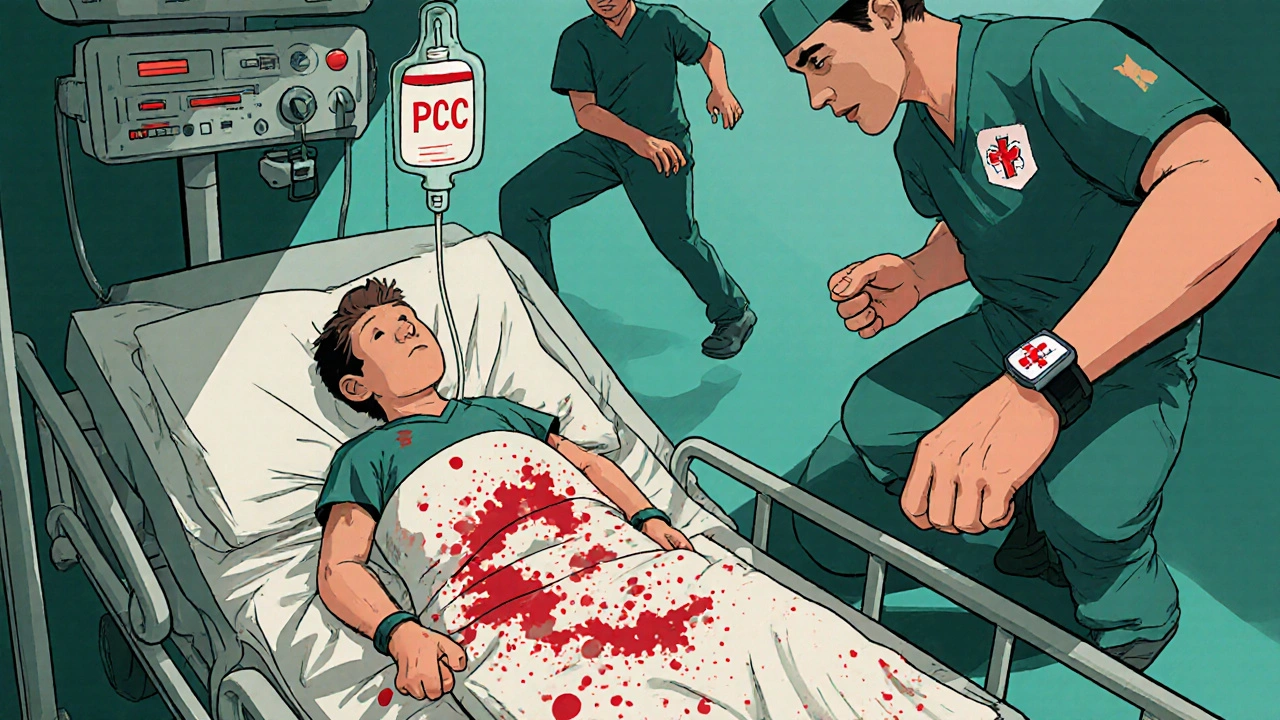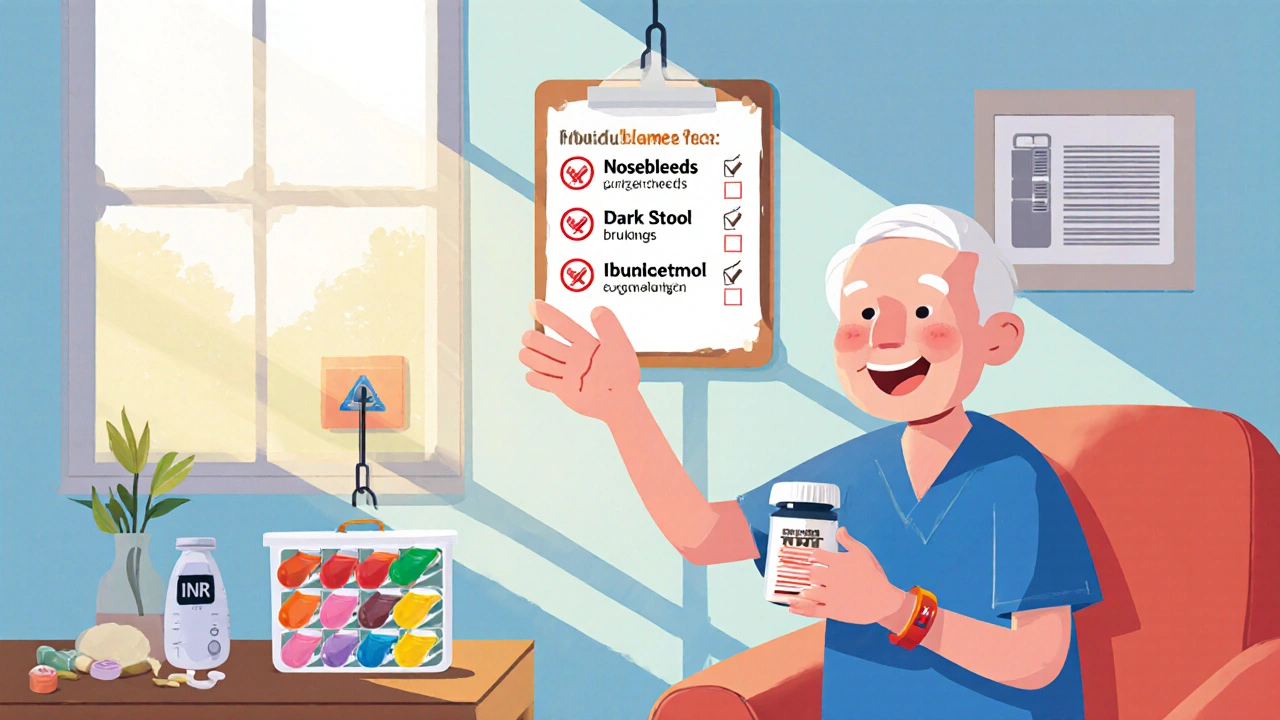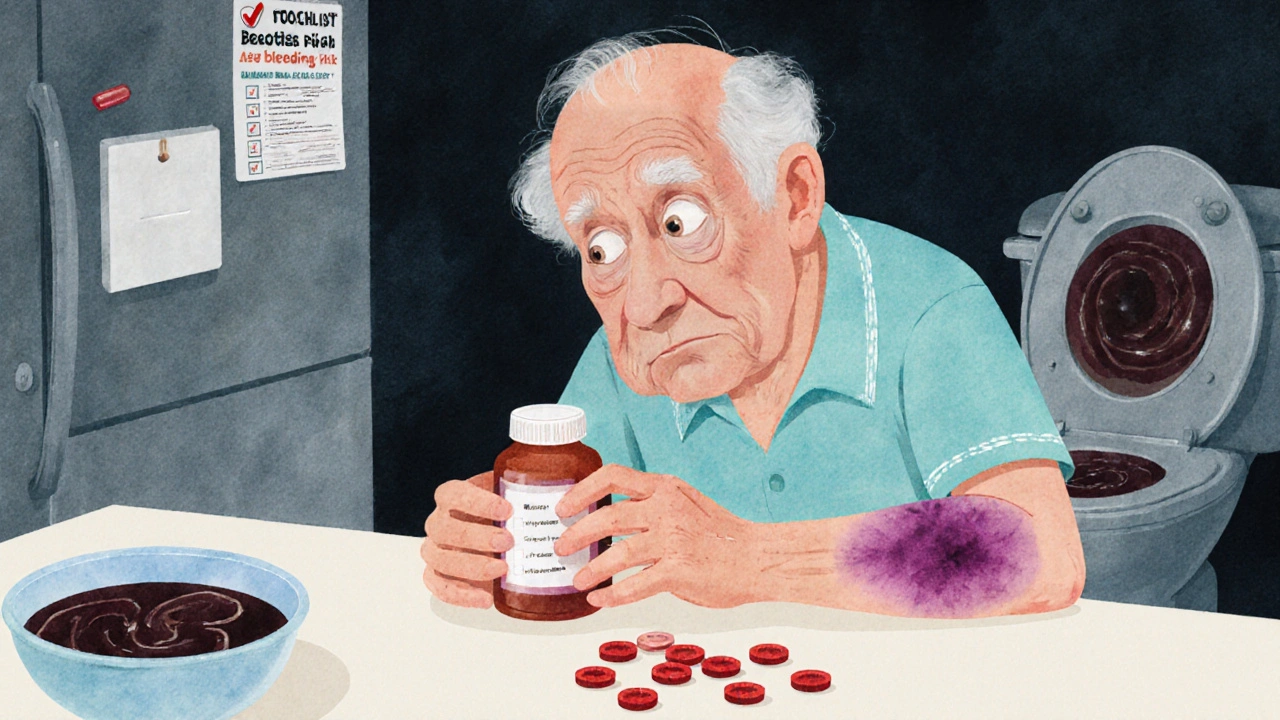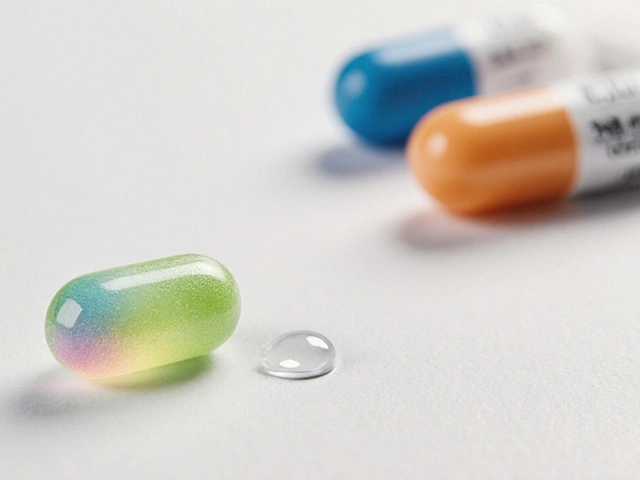When you take a blood thinner, you’re balancing a fine line. These medications save lives by stopping dangerous clots from forming in your heart, legs, or brain. But if you take too much - even by accident - you risk life-threatening internal bleeding. And the scary part? You might not feel it coming until it’s too late.
What Happens When a Blood Thinner Goes Wrong?
Blood thinners like warfarin, apixaban (Eliquis), rivaroxaban (Xarelto), and dabigatran (Pradaxa) work by slowing down your blood’s ability to clot. That’s good when you have atrial fibrillation or a history of deep vein thrombosis. But if your dose is too high, or you accidentally take two pills, your body can’t stop bleeding - even from tiny injuries.Warfarin, the oldest of these drugs, has been around since the 1950s. It’s still used by millions, especially older adults. But it’s tricky. Your blood needs to be checked regularly with an INR test. A normal INR is between 2.0 and 3.0 for most people. If it climbs above 4.5, you’re in danger zone. For those with mechanical heart valves, anything over 3.5 is risky.
Newer drugs - called DOACs - don’t need daily blood tests. But they’re not safer. They can still cause bleeding, and their effects last longer than people think. One dose of rivaroxaban can stay active in your system for up to 24 hours. If you overdose, the bleeding doesn’t wait for you to feel ready.
Signs You’re Bleeding Internally
Internal bleeding doesn’t always look like a gushing wound. Sometimes, it’s silent. Here’s what to watch for:- Dark, tarry stools - This isn’t just from eating beets. It’s digested blood from your stomach or intestines.
- Bloody or pink urine - Red or brown pee means bleeding in your kidneys or bladder.
- Vomiting blood - Or material that looks like coffee grounds. That’s old, clotted blood.
- Unexplained bruising - Big purple patches that show up without bumping into anything.
- Persistent nosebleeds or gum bleeding - If pressure doesn’t stop it after 10 minutes, it’s not normal.
- Severe headaches, dizziness, or confusion - Could mean bleeding in your brain.
- Sharp pain in your back, belly, or chest - Especially if it comes on suddenly.
- Extreme fatigue or shortness of breath - Your body is losing blood and can’t carry oxygen.
One patient on Reddit shared how he ignored dark stools for three days. "I thought it was the steak I ate," he wrote. By the time he went to the ER, his hemoglobin had dropped to 6.2 g/dL - half the normal level. He needed three units of blood and a week in the hospital.
What to Do Right Now
If you suspect an overdose - whether you took too much by accident, or someone else did - act fast. Every minute counts.- Call 999 immediately. Don’t wait. Don’t text. Don’t call your GP. This is an emergency.
- Do not take another dose. Even if you think you missed one. Wait for medical help.
- Write down what you took. Name of the drug, dose, and time. If you don’t know, bring the pill bottle.
- Lie down and stay still. Movement can make bleeding worse. Elevate your legs slightly if you’re dizzy.
- Apply firm pressure to any external bleeding. Use a clean cloth. Hold it for at least 10 minutes. Don’t peek.
- Do NOT take aspirin, ibuprofen, or naproxen. These make bleeding worse. Even a single tablet can be dangerous.
Many people delay because they think it’s "just a nosebleed" or "a bit of stomach upset." But according to Johns Hopkins, nearly 3 out of 10 patients wait more than 12 hours before seeking help. By then, it’s often too late for simple fixes.

How Hospitals Treat Overdose
Treatment depends on which drug you took and how bad the bleeding is.If it’s warfarin:
- For high INR without bleeding: Doctors give oral vitamin K - usually 1 to 5 mg. It takes hours to work.
- For active bleeding: They give 4-factor Prothrombin Complex Concentrate (PCC). This is a concentrated mix of clotting factors that works in minutes. It’s expensive - around £1,500 per dose - but lifesaving.
- They may also give intravenous vitamin K and, if needed, fresh frozen plasma. But PCC is faster and safer.
If it’s a DOAC (Eliquis, Xarelto, Pradaxa):
- For dabigatran (Pradaxa): There’s a specific antidote called idarucizumab. It reverses the drug in under 10 minutes.
- For apixaban or rivaroxaban: Andexanet alfa is the antidote. It’s rare, expensive, and only in major hospitals.
- If no antidote is available: Doctors may use activated charcoal (if taken within an hour) or dialysis (for dabigatran only).
There’s also a new drug in trials called ciraparantag - a universal reversal agent that could work on all blood thinners. It’s not approved yet, but early results show it can stop bleeding in under 30 minutes.
Prevention Is the Best Medicine
Most overdoses are preventable. Here’s how:- Use a pill organizer. Color-coded ones with alarms help. Don’t rely on memory.
- Keep a bleeding risk checklist. Post it on your fridge. Include: nosebleeds >10 min, dark stools, red urine, unexplained bruising, severe headache.
- Get regular INR tests if on warfarin. Weekly at first. Monthly once stable. Don’t skip them.
- Talk to your pharmacist. Many pharmacies offer free anticoagulation monitoring. Ask.
- Wear a medical alert bracelet. It tells paramedics you’re on blood thinners - even if you’re unconscious.
- Avoid alcohol and certain supplements. Garlic, ginkgo, fish oil, and St. John’s wort can increase bleeding risk.
A 2022 study found that patients who used a point-of-care INR monitor at home - a small device you prick your finger for - had 34% fewer major bleeding events. These devices cost around £200-£300, but many NHS trusts provide them to high-risk patients.

What to Expect After an Overdose
Surviving an overdose doesn’t mean you’re done. You’ll likely need to:- Stay in the hospital for monitoring - often 2 to 5 days.
- Have repeat INR or anti-Xa blood tests to make sure the drug is cleared.
- Adjust your dose or switch to a different blood thinner.
- See a hematologist for long-term management.
Some people never go back on blood thinners after a major bleed. Others do - but with stricter rules: lower doses, more frequent checks, and no NSAIDs ever again.
Why This Matters More Than You Think
In the UK, anticoagulant-related bleeding is the second most common cause of serious medication errors in adults over 65, according to the CDC. Every year, thousands end up in hospital because of a simple mistake: taking an extra pill, mixing up doses, or ignoring early signs.The cost? On average, each major bleeding event costs the NHS over £22,000. But the real cost is what you lose - your independence, your mobility, your peace of mind.
It’s not about being perfect. It’s about being prepared. Know the signs. Know what to do. And if in doubt - call 999. Better to be safe than sorry.
What should I do if I think I took too much of my blood thinner?
Call 999 immediately. Do not wait for symptoms to get worse. Do not take another dose. Bring the medication bottle with you to the hospital. Write down the time and amount you took if you can.
Can I reverse a blood thinner overdose at home?
No. There are no safe or effective home remedies to reverse a blood thinner overdose. Vitamin K works for warfarin, but it takes hours and must be given under medical supervision. Trying to treat this yourself can be deadly. Always go to the hospital.
Are newer blood thinners safer than warfarin?
They’re easier to use - no regular blood tests needed - but they’re not safer. They still cause serious bleeding. The advantage is that some have specific antidotes (like idarucizumab for Pradaxa). But if you bleed badly, you still need emergency care. Never assume they’re "accident-proof."
Can I take painkillers like ibuprofen while on blood thinners?
No. Never take ibuprofen, naproxen, or aspirin while on blood thinners unless your doctor says so. These drugs increase bleeding risk and can turn a minor issue into a life-threatening one. Use paracetamol instead - it’s much safer.
How long does it take for blood thinners to leave my system?
It varies. Warfarin can stay active for up to 5 days. DOACs like Eliquis and Xarelto last about 12-24 hours. But if you overdose, your body may take longer to clear the drug - especially if you’re older or have kidney or liver problems. Always follow up with your doctor after any overdose.
Should I wear a medical alert bracelet if I’m on blood thinners?
Yes. If you’re on long-term anticoagulant therapy, a medical alert bracelet is one of the most important things you can wear. In an emergency, paramedics won’t know what you’re taking - but they’ll see the bracelet. It can save your life.






shubham seth
November 17, 2025 AT 17:17Yo this post is straight fire 🔥. Blood thinners are basically silent assassins in your veins. One wrong pill and boom - your body starts leaking like a sieve. I’ve seen guys on warfarin turn into human juice boxes after skipping their INR checks. No cap. The system is rigged - pharma makes billions while you’re left guessing if that bruise is from yoga or internal hemorrhage.
kora ortiz
November 17, 2025 AT 21:28Call 999. No excuses. No waiting. No Google searches. If you think you overdosed - go. Now. Your life isn’t a TikTok trend. This isn’t drama. This is survival. Period.
Kathryn Ware
November 18, 2025 AT 06:49I’m a nurse in ICU and I’ve seen this too many times. People ignore dark stools because they ‘ate beets’ - then show up with Hgb 5.8 and a family crying in the hallway. The DOACs? Yeah they’re easier but don’t fool yourself. One guy took two Xarelto pills thinking he missed one. He bled into his abdomen for 36 hours before he passed out. No pain. No warning. Just… gone. Please use pill organizers. Set alarms. Write it on your mirror. Your future self will thank you. And if you’re on warfarin - get that home monitor. It’s life-changing. My patients who use them? 70% fewer ER visits. It’s not expensive - it’s priceless. 💙
Jeremy Hernandez
November 19, 2025 AT 09:12LMAO they say ‘call 999’ like it’s that simple. What if you’re poor? What if you don’t have insurance? What if you’re 72 and live alone and your phone died? This whole post is written by someone who’s never had to choose between medicine and groceries. Meanwhile the NHS is charging £1500 for a dose of PCC like it’s designer perfume. Wake up. This isn’t medicine - it’s capitalism with a stethoscope.
Tarryne Rolle
November 20, 2025 AT 19:41Isn’t it ironic? We’re told to trust science - yet the very drugs meant to save us are the ones that can kill us silently. We live in a world where your life depends on a number - INR - that only a lab can tell you. We’re not patients. We’re data points in a corporate algorithm. And now they want us to buy home monitors? Like it’s a fitness tracker. The real tragedy isn’t the overdose - it’s that we’ve been conditioned to accept this as normal.
Kyle Swatt
November 22, 2025 AT 07:45There’s a quiet violence in how we treat anticoagulation. We hand out pills like candy and then act shocked when people bleed out. We don’t teach this stuff in schools. We don’t train families. We just say ‘take this’ and walk away. It’s like giving someone a chainsaw and saying ‘be careful’ - then blaming them when they cut their leg off. The antidotes exist - but only in fancy hospitals. That’s not healthcare. That’s lottery medicine. We need universal access. Not just for the rich or the insured. For everyone. Because life isn’t a privilege. It’s a right.
Deb McLachlin
November 22, 2025 AT 17:48While the information presented is clinically accurate and comprehensive, I would like to respectfully suggest that the reference to the CDC as the source for UK anticoagulant error statistics is inaccurate. The CDC is the United States Centers for Disease Control and Prevention; for UK-specific data, Public Health England or the NHS Digital would be more appropriate sources. Additionally, the cost figures cited (£22,000 per event) should ideally be corroborated with peer-reviewed health economics literature to ensure methodological validity. This does not diminish the urgency of the message, but precision in sourcing enhances credibility in public health communication.
Leslie Douglas-Churchwell
November 24, 2025 AT 03:19Let’s be real - this isn’t about ‘overdose’ or ‘mistakes.’ This is a cover-up. The pharmaceutical giants designed these drugs to be ‘convenient’ so you’d stay hooked… while quietly engineering the need for expensive antidotes. Idarucizumab? Andexanet alfa? Those aren’t miracles - they’re profit engines. And the ‘home INR monitor’? Sold for £300? But the NHS won’t cover it unless you’re ‘high risk’ - which means you have to bleed first. Classic. They want you dependent. They want you scared. They want you paying. Wake up. The real blood thinner isn’t warfarin - it’s the system.
And don’t even get me started on ‘St. John’s wort’ being blamed. Who’s really profiting from your fear of herbs? Big Pharma. Always. 🌿💊👁️🗨️
saurabh lamba
November 25, 2025 AT 14:12Bro why are we even talking about this? If you’re on blood thinners you’re basically a walking time bomb. Why not just stop? I mean… life’s short anyway. Why risk it? Just chill. Eat some garlic. Drink some fish oil. Let the clots come. Maybe God’s trying to tell you something.
Kiran Mandavkar
November 26, 2025 AT 06:31You people are so naive. You think a pill organizer will save you? You think wearing a bracelet makes you safe? This is all theater. The real danger is that your doctor doesn’t even know how these drugs interact with your genetics. No one runs a pharmacogenomic test. No one checks your CYP2C9 or VKORC1 variants. You’re just a guinea pig in a global trial. And the ‘antidotes’? They’re barely tested. Ciraparantag? Sounds like a Marvel villain. You’re not being saved - you’re being monetized.
Eric Healy
November 27, 2025 AT 06:01Just got back from the ER after taking two Xarelto by accident. Thought I missed one. Didn’t feel a thing. No bruising. No blood. Just a weird headache. They gave me PCC and I’m fine. But y’all need to know - it’s not the pill. It’s the fear. You panic. You overthink. You Google. Then you end up in the hospital for nothing. If you’re not bleeding - breathe. Call your doc. Don’t call 999 unless you’re vomiting blood or your head feels like it’s splitting. I’m alive. I’m lucky. But don’t turn every mistake into a crisis.
Joseph Townsend
November 28, 2025 AT 15:54So I took 3 Eliquis pills last week. Thought I was on a 12-hour schedule. Turns out it’s 12 hours apart - not 3 times a day. I didn’t bleed. Didn’t even feel weird. But now I’m terrified to move. I’m sleeping with a tourniquet on my arm. I’ve started carrying a vial of vitamin K in my purse. I’m not joking. My cat looks at me like I’m the villain now. I’m not okay. And honestly? I don’t think the system cares. They just want you to keep buying the pills. 💔🩸